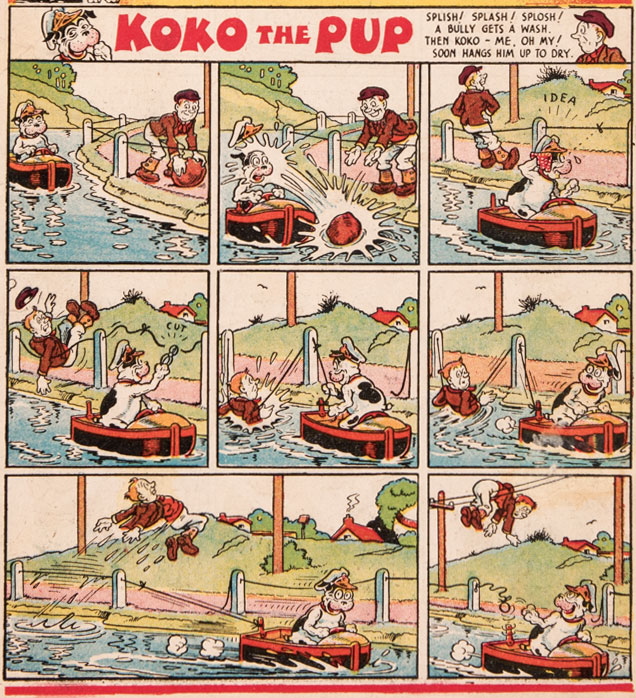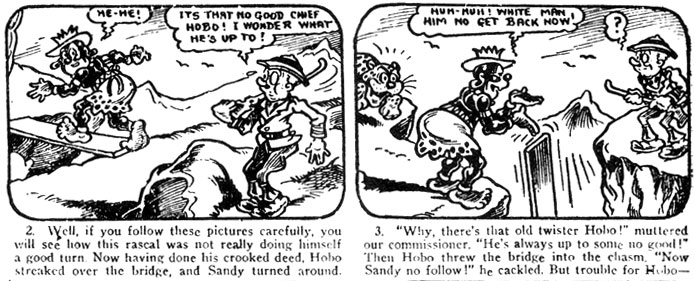'Koko the Pup' (The Magic Comic, 29 July 1939).
Harry Banger was a mid-20th century British comic artist. He drew various gag comics for the top children's magazines of the Amalgamated Press and D.C. Thomson, but did his best work for smaller publishers like Target Publications, Gerald Swan and Georges Newnes Limited. Among his best-remembered features are 'Koko the Pup' (1939-1941) for DC Thomson, 'Chubb and Tubb' (1940-1948), 'Skit the Kat' (1940-1946) and 'Stoogie' (1940-1951) for Swan, and 'Dilly Duckling' (1952-1958) for Newnes. Banger was part of a small group of artists living in Norwich, which also included Don Newhouse, Roy Wilson and Louis Briault.
Early life and career
Edgar Henry Banger (his last name was pronounced as "Bainjer") was born in 1897 in Norwich. His father had a photographic studio in Exchange Street, Market Place, Norwich from1896. He left school early and despite any formal art training managed to get a job as a sports cartoonist for The Eastern Daily Press, Evening News and The Pink Un, the local football club paper of Norwich City. Banger excelled in cartoons about association football and created two characters: Canary and Dumpling. In 1926, he became a freelance artist for the Amalgamated Press. His first comic series were 'Steve Sticket' (1926) in Butterfly, 'Enoch Hard' (1926) in Comic Cuts and 'Curly Crusoe' (1926) in Illustrated Chips. Throughout the rest of the 1920s and well into the next decade, he drew for various AP comics like The Monster Comic ('Boots, Buttons and Butler'), Crackers ('Tubby and Trot'), Funny Wonder ('Oggle and Woggle') and Jolly ('Jolliboy Farm').
'Sandy Cove the Comical Commissioner' (Target and Rocket, 29 October 1938).
Target Publications
During the 1930s, Banger was an artist for the weeklies of Target Publications in Bath, such as Rattler, Dazzler, Rocket and Bouncer, among others. He was part of editor Louis Diamond's regular artist team, which also included Bert Hill, G. Larkman, S.K. Perkins and Diamond himself. One of Banger's features was 'Addy and Squibs' (Rocket, 1935-1938), originally titled 'The Admiral's Log', which dealt with Admiral Applecart and his crew on board the flagship Popcorn. For Target, he made the historical knights feature 'Boney Prince Charlie' (1935-1938), as well as 'The Demonstrations of Dudley Dudd the Dud Detective' (1935-1938), while Rattler published his Stone Age comic strip 'Cliff and Clump' (1938).
In 1938, Banger created the comic 'Sandy Cove the Comical Commissioner' for "Target and Rocket", a merger of two magazines. Between 1936 and 1938, he also made graphic contributions to Target's giveaway comic magazine Ovaltiney's Own Comic, based on the popular Radio Luxembourg show 'Ovaltiney's Concert Party' (1936-1939) by comedian Harry Hemsley. The magazine featuring 'The Adventures of Elsie, Winnie and Johnny' (1936), served as a supplement to the other Target magazines.
DC Thomson's The Magic Comic
By the end of the 1930s, Banger moved to DC Thomson, where 'Koko the Pup' (1939-1941) appeared on the front page of The Magic Comic, from the first until the last issue. For the same title he developed 'Inky, Binky and Fluff' (1939-1940), another funny animal feature based on the nursery rhyme 'The Three Little Kittens'.
'Coal Black Jones' (Coloured Slick Fun #74).
Work for Gerald Swan
Arguably, Banger did some of his best work for the comic magazines published by Gerald Swan, starting in 1940 and lasting well into the 1950s. He became Swan's top artist for not only his wartime magazines in the American comic book format, but also the post-war regular format magazines and annuals, including New Funnies, Topical Funnies, War Comics, Thrill Comics, Slick Fun, Fresh Fun and Extra Fun. Many of his features, signed with simply "Bang", were not limited to one single comic book. The two chubby cavemen 'Chubb and Tubb' (1940-1948), for instance, appeared in several of the early Swan titles, just like the unlucky 'Sammy Specks, Our Extra Special Constable' (1940-1945). The same goes for 'Coal Black Jones' (1940-1946). This black kid was drawn in a way one could expect of that time period, although his adventures in a Southern shanty town were not affected by any further racial stereotyping.
However, Banger's World War I themed strip about the two soldiers 'Nobby and Pip' (1940-1943) appeared solely in War Comics. The jungle strip 'Exploring with Professor Peek and Fuzzy' (1940-1948) and the puss on the prowl 'Skit the Kat' (1940-1946) also ran in several titles, but were mostly associated with Slick Fun. Bang's longest running Swan feature was 'Stoogie' (1940-1951), about a big-nosed idiot who often got himself into trouble. Between 1953 and 1956, Banger developed this character into a superhero named 'Superstooge'.
'Skit the Kat' (Coloured Slick Fun #86).
In 1945, Banger returned to his nursery comic style with funny animal features like 'Gyp the Gnome' and 'Piggy Wiggy' in Swan's Kiddyfun. Other notable work for Swan were the features 'All at Sea', 'P.C. Farthing', 'Slicksure the famous Secret Agent' (1940-1949), the clowns 'Cheery and Chirpy', the western strip 'Tornado Tom' (1940-1950) and 'What Price Glory' (1940-1948), about a skinny spinster, and his many cover illustrations for the Swan annuals.
Cover illustrations for Slick Fun issue #83 and Slick Fun album 36.
Small publishing labels
Besides his work for Gerald Swan, Harry Banger contributed to several other small publishing labels. Humor features by Banger appeared in Paget Publications titles like Paget Fun, Paget's Happy Laughs, Paget's Gusto, Paget's Sure-Fire and Paget's Superduper, and in titles by Martin & Reid and Georges Newnes Limited. He made his last known comics for Newnes' Sunny Stories during the 1950s. The centerspreads he made with writer Arthur Groom about 'The Adventures of Dilly Duckling' (1952-1958) were very popular. They even led to the publication of a children's book with the little duck and his family, 'The Adventures of Dilly Duckling' (Newnes, 1956). However, Dilly was not their own creation. Ken Reid had already thought up the character for a one shilling pamphlet published by Brockhampton Press in 1948. Another mid-1950s feature by Banger for Sunny Stories was 'Funny Folk of Meadow Bank'.
Death
Harry Banger passed away in 1968, at the age of 71.










